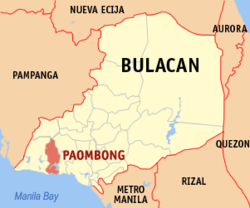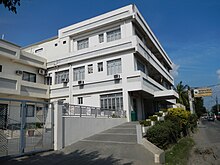Paombong
Municipality of Paombong
Bayan ng Paombong | |
|---|---|
 | |
| Nickname: Vinegar Capital of the Philippines | |
| Motto: Abante Bagong Paombong Pantay Pantay na Karapatan sa Pag-asa sa Kaunlaran | |
 Map of Bulacan showing the location of Paombong | |
| Country | Philippines |
| Region | Central Luzon (Region III) |
| Province | Bulacan |
| District | 1st District |
| Founded | 1619 |
| Barangays | 14 |
| Government | |
| • Mayor | Isagani "Pera" G. Castro (Independent) |
| • Vice Mayor | Marissa Jumaquio-Ramos (Liberal Party) |
| Area | |
| • Total | 46.34 km2 (17.89 sq mi) |
| Highest elevation | 15 m (49 ft) |
| Population (2010)[3] | |
| • Total | 50,940 |
| • Density | 1,100/km2 (2,800/sq mi) |
| • Poverty rate | |
| Demonym | Paombongenyo |
| Time zone | UTC+8 (PST) |
| ZIP code | 3001 |
| Dialing code | 44 |
| Income class | 3rd Class; Partially Urban |
| Electricity | Manila Electric Company |
| • Consumption | 12.18 million kWh (2003) |
Paombong (Filipino: Bayan ng Paombong) is a third class partially urban[4] municipality in the province of Bulacan, Philippines. Dubbed as the "Vinegar Capital of the Philippines", Paombong is famous for its vinegar[5] extracted from the sap of sasa (nipa), thus the term "sukang Paombong" (Paombong vinegar) became known in Luzon and other parts of the Philippines. According to the 2010 census, it has a population of 50,940 inhabitants.[3]
Etymology
Local legend has it that the name "Paombong" was taken from the long bamboo tube called "bumbong" or "tukil" which is used for collecting nipa sap. The practice of extracting nipa sap with bumbongs made the town known as the town with many bumbongs.
The local people claimed that the Spaniards who first visited the place were so amused with the bumbong that, after learning its name from the natives, they named the town after the container, a name which later evolved to Paombong.
History
Paombong was originally one of the visitas (barrio) of Malolos mentioned in Capitulo XXXVI of Conquistas de Las Islas libro segundo by Fray Gaspar San Agustin.In a meeting held in Tondo Convent,the Provincial Chapter created the Town of Malolos in June 1580 with Fray Mateo Mendoza OSA as its first minister,together with Barrio Mambog under the patronage od San Roque,Matimbo with Santa Cruz and Paombong with Santiago Apostol.In 1619 Augustinians established Paombong Convent and not long after, civilian rulers took over, but their reigns were dictated upon and was under the mercy of the friars.
In 1639 Paombong was turned over to Calumpit from its mother town Malolos and in 1649 it was returned again to Malolos but in November 28, 1650 it was given it own civil government establishing Paombong its full township. With Don Agustin Managhaya as its first Gobernadorcillo.
In the middle of the 1750s, Paombong grew into a modest community from what was once a cogon land inhabited by a handful of Tagalogs.[6] as its first gobernadorcillo.
During the Revolution against Spain, Paombong’s coastal area, more specifically, Barangays Masukol and Binakod, played a significant role in Philippine History being known encounter sites between Spanish soldiers and Katipuneros. Maloleño General Isidoro "matanglawin" Torres[7] used to retreat with his troops to Barangay Masukol and Barangay Binakod to avoid the advancing Spanish forces.[citation needed] In the latter village, he organized the Katipunan militia of Paombong.[8]
It is from these encounters, in fact, that Barangays Binakod and Masukol earned their present names. In one encounter, Binakod was where the enemies where "fenced in" (binakuran) and it was in Masukol where they were eventually "cornered" (nasukol) and defeated.
In 1898, the first civilian in the person of Don Victorio de Leon headed the Municipal Government until 1900. The seat of the local government was first established at the ground floor of the Paombong Church Convent then popularly called "silong". It was later transferred to the house of Numeraino Lindayag located in Poblacion, then was transferred to the location of the present Rural Health Center I. Eventually it was moved to the place where it is presently located which since has been the seat of the Municipal Government since then. In 1941, the head of the Municipal Government was later on called Municipal Mayor.
Geography
Paombong is situated south-west of the province of Bulacan, with a total land area of 46.34 square kilometers. It is bounded by the municipality of Calumpit on the north, Malolos City on the east, municipality of Hagonoy on the west and Manila Bay on the south. The municipality is approximately 47 kilometers from Metro Manila, it is a by-pass town and can be accessed via North Luzon Expressway and MacArthur Highway.
Barangays
Paombong is politically subdivided into 14 barangays (6 urban, 8 rural):[2]
- Binakod (sitio matalaba)
- Kapitangan - This barangay is a famous pilgrimage site during the Holy Week, particularly Good Friday. Some devout Catholic worshippers flagellate and/or allow themselves to be crucified to repent and share in the sufferings of Jesus Christ.[9]
- Malumot
- Masukol
- Pinalagdan
- Poblacion
- San Isidro I
- San Isidro II
- San Jose - cradle the largest "sasahan" in town, subdivided into 7 political sitio or "purok" (Sitio Uno, Gitna, Sitio Tres, Sitio Wawa, Sitio Pantay, Sito Gunao and Sitio Kulis ). It is also a political hot spot every election for National and Local Positions. The San Jose Fishport located at Sitio Wawa cradles the motor boats or "bangka" which serves as the major transportation going to the three barangays near the Manila Bay, namely, Sta. Cruz, Masukol and Binakod.
- San Roque
- San Vicente
- Sta. Cruz - There are 2 main resources of this barangay, fishponds and "asinan" or salt making. In this coastal barangay you can see some salt evaporation ponds.
- Sto. Niño
- Sto. Rosario
Demographics
| Year | Pop. | ±% p.a. |
|---|---|---|
| 1990 | 32,052 | — |
| 1995 | 33,149 | +0.63% |
| 2000 | 41,077 | +4.70% |
| 2007 | 50,798 | +2.97% |
| 2010 | 50,940 | +0.10% |
| Source: National Statistics Office[3] | ||
Local government

Just as the national government, the municipal government is divided into three branches: executive, legislative and judiciary. The judicial branch is administered solely by the Supreme Court of the Philippines. The LGUs have control of the executive and legislative branch.
The executive branch is composed of the mayor and the barangay captain for the barangays.[10] The legislative branch is composed of the Sangguniang Bayan (town assembly), Sangguniang Barangay (barangay council), and the Sangguniang Kabataan for the youth sector.
The seat of Government is vested upon the Mayor and other elected officers who hold office at the Town hall. The Sanguniang Bayan is the center of legislation.
Municipal officials
The following officials were elected on May 13, 2013 to serve a three-year term.[1]
- Mayor: Isagani "Gani" G. Castro 'VOTE BUYER'- (independent)
- Vice Mayor: Marisa Jumaquio-Ramos - (Liberal Party)
- Councilors
- Myrna G. Valencia - (Liberal Party)
- Arnold Mendoza - (Liberal Party)
- Frank Valencia - (Independent)
- Luisito "Louie" S. Arellano - (Independent)
- James Jester Santos - (Liberal Party)
- Max Tanghal - (Liberal Party)
- Erning Sulit - (Liberal Party)
- Toto Estrella - (Liberal Party)
Trade and commerce

Trade and commerce in Paombong is concentrated at the town center where the public market, municipal hall, church, schools, hospital, clinics, and commercial spaces are situated but the town lacks in banking institution, large universities and colleges, hence most of the residents go the the nearby capital, The town has various resorts, services, centers, ponds and industries. The main products are Condiments (Vinegar "well known as Sukang Paombong", Fish Sauce (patis), Salt, Etc.), Nipa (pawid), and Other Agricultural products like Livestocks, Poultry, Rice, Fish, Fruits and Vegetables. The San Jose Fishport in Sitio Wawa is the center of fish trades. Fish ends at the market. Ponds are also sources of fishes.
Attractions
- St. James the Apostle Parish Church: The town church of Paombong originally built as visita of Malolos in 1580, established as parish in 1639 made of light materials. It suffered a massive fire causing it to lost its ancient architecture. It was reconstructed in 1970s and reconstructed again in 2003,
- Ciudad Clementino, the prime resort of the small town was the venue of Sa Sandaling Kailangan Mo Ako soap opera.[11]
- Kapitangan Good Friday Crucifixion: International media focuses every Good Friday on the Crucifixion at Barangay Kapitangan.[12] It is known as a pilgrimage area, spiritual healers' haven and venue of a reenactment of the Passion of Christ is held by local devotees and penitents.
-
St. James the Apostle Parish Church
-
Ciudad Clementino, main pool
-
Kapitangan Chapel
Transportation
- First North Luzon Transit (from Hagonoy terminal going to Cubao Divisoria and Pasay)
- Baliwag Transit (from Hagonoy terminal going to Cubao, Divisoria and Pasay)
- Jeepneys (going to Bocaue, Balagtas and Meycauayan)
- Customized Owner type Jeep "Karatig Jeep" (going to Malolos Bayan, Malolos Crossing)
- Tricycles (most common mean of transportation locally)
- Pedicab (a bicycle with a sidecar)
- Bangkas or motor boats (most common mean of transportation in Sta. Cruz, Binakod, Lantad and Masukol)
- Fx
Health and Nutrition

There is one hospital operating in Paombong and a main rural health care center unit. The San Pascual Baylon Maternity Hospital, situated at Barangay Sto. Niño that offers secondary healthcare services. And the main rural health care center is one of the district rural health center owned and controlled by the Provincial Government of Bulacan. It offers primary healthcare services which also includes laboratory and dental and maternity services.
Education
Private schools
- Binuya's Kiddie School
- St. Martin de Porres Catholic School
- Paombong High School
- Holy Rosary School of Paombong
- St. Dominic School in Hangga San Isidro II
Public schools
Elementary Schools
High Schools
References
- ^ a b "Paombong - Certified List of Elected Candidates". Commission on Elections. Retrieved 2009-08-16.
- ^ a b "Province: BULACAN". PSGC Interactive. Makati City, Philippines: National Statistical Coordination Board. Retrieved 10 October 2013.
- ^ a b c "Total Population by Province, City, Municipality and Barangay: as of May 1, 2010" (PDF). 2010 Census of Population and Housing. National Statistics Office. Retrieved 10 October 2013.
- ^ http://www.nscb.gov.ph/activestats/psgc/municipality.asp?muncode=031416000®code=03&provcode=14
- ^ "Paombong Bulacan Suka Festival". Central Luzon. Retrieved 2009-08-05.
- ^ http://www.paombong.gov.ph/index.php?option=com_content&task=view&id=86&Itemid=106
- ^ http://philippine-revolution.110mb.com/torres_detailed.htm
- ^ "Isidoro Dayao Torres: Revolutionary Leader". Pambansang Suriang Pangkasaysayan. Retrieved 2009-08-05.
- ^ "Flagellants and Lenten Rites". Experience Bulacan. Province of Bulacan. Retrieved 2009-08-05.
- ^ Local Government Code of the Philippines, Book III, Department of Interior and Local Government official website
- ^ http://www.philstar.com/Article.aspx?articleId=162902
- ^ http://www.paombong.gov.ph/index.php?option=com_content&task=view&id=81&Itemid=100




